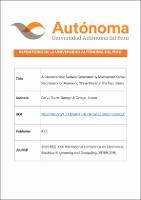| dc.contributor.author | De La Torre, Dennys | |
| dc.contributor.author | Ortega, Arturo | |
| dc.date.accessioned | 2023-12-27T22:12:24Z | |
| dc.date.available | 2023-12-27T22:12:24Z | |
| dc.date.issued | 2023 | |
| dc.identifier.uri | https://hdl.handle.net/20.500.13067/2919 | |
| dc.description.abstract | The Peru Basin is an unexplored source of clean energy. Projects to install wave farms in this region depend on assessing the energy power that this domain can offer. The state-of-the-art indicates that the technology for this evaluation has been developed for ocean conditions belonging to the Northern Hemisphere of the Earth. Those conditions are far from the local ocean conditions of the Peru Basin, characterised to be an open sea. Consequently, that technology is not proper for wave power evaluation of the Peru Basin. This work proposes a characteristic surface as a tuning parameter for calculating the wave power based on the significant wave height and characteristic wave periods as either the zero-up-crossing or the peak periods. A data-Kernel model, which produces the characteristic surface, is generated based on a multivariate Kernel regression that trains spectral data of May of twelve years from an ocean buoy located in the Peru Basin. This work presents 3D scatter plots of wave power calculated based on entirely spectral data and depending on the significant wave height and the characteristic wave periods. The plots show that high values of significant wave height correspond to high wave power values. Based on that, the Kernel regression is able to generate a 3D data model relating wave power, significant wave height and the characteristic periods. Then, the characteristic surface is generated by combining this data-Kernel model with the well-known spectral parametric formulation for wave power. This characteristic surface can be considered a tuning parameter. For the estimation of wave power, the characteristic surface combined with the spectral parametric formulation generates excellent results with a global error equal to zero in contrast to the traditional Bretschneider and JONSWAP approaches. Moreover, locally, more than 60 % and 30 % of the results present errors lower than 5 % when the zero-up-crossing period and the peak period, respectively, are used in the calculations. This data-Kernel model is a considerable improvement in contrast to the state-of-the-art approaches. The generated characteristic surface can be used for the whole Peru Basin as this is essentially an open sea. | es_PE |
| dc.format | application/pdf | es_PE |
| dc.language.iso | eng | es_PE |
| dc.publisher | IEEE | es_PE |
| dc.rights | info:eu-repo/semantics/restrictedAccess | es_PE |
| dc.rights.uri | https://creativecommons.org/licenses/by-nc-nd/4.0/ | es_PE |
| dc.subject | Sea surface | es_PE |
| dc.subject | Three-dimensional displays | es_PE |
| dc.subject | Uncertainty | es_PE |
| dc.subject | Wave power | es_PE |
| dc.subject | Surface waves | es_PE |
| dc.subject | Computational modeling | es_PE |
| dc.subject | Data models | es_PE |
| dc.title | A Characteristic Surface Generated by Multivariate Kernel Regression for Assessing Wave Power in the Peru Basin | es_PE |
| dc.type | info:eu-repo/semantics/article | es_PE |
| dc.identifier.journal | 2023 IEEE XXX International Conference on Electronics, Electrical Engineering and Computing (INTERCON) | es_PE |
| dc.identifier.doi | https://doi.org/10.1109/INTERCON59652.2023.10326026 | |
| dc.subject.ocde | https://purl.org/pe-repo/ocde/ford#2.07.00 | es_PE |


